Best Tripods for Wildlife Photographers
Why Tripods Matter in Wildlife Photography
When you’re out in the field – knees deep in mud, mosquitoes buzzing in your ears, and your eye locked on the viewfinder – you’ve already got enough on your plate. That’s why having one of the best tripods for wildlife photographers is essential. The last thing you need is a shaky setup ruining that once-in-a-lifetime shot of an eagle mid-dive or a mountain lion stepping from the shadows. A reliable tripod keeps your focus where it belongs: on the moment.
The Hidden Power of Stability
Whether you’re working with a featherlight mirrorless setup or hauling around a beast of a super-telephoto lens, one thing remains true – a solid support system is non-negotiable. While a quality tripod (or monopod) obviously helps eliminate camera shake, it also transforms your approach. It gives you the freedom to slow down, refine your composition, and wait for magic to unfold, whether it’s an owl gliding silently past or a deer bathed in golden-hour light.
Why Not Just Go Handheld?
Moreover, using a tripod isn’t just about technical quality – it’s about experience. Rather than rushing through handheld shots, you’re grounded in the scene. You become more patient, more observant, and ultimately more connected to the wild moments you’re trying to capture. And let’s be honest – handholding an 800mm lens for any serious length of time? That’s a shortcut to blurry images and a fast pass to the chiropractor.
Choosing the Right Tripod Can Be Overwhelming
With so many options on the market – carbon fiber vs. aluminum, ball head vs. gimbal, 3-section vs. 4-section it’s easy to feel overwhelmed. That’s exactly why we’ve put together this guide to the Top 10 Best Tripods for Wildlife Photographers in 2025.
A Curated List of Tripods for Every Wildlife Photographer
Rather than rank these tripods in strict order, we’ve curated a list of tripods for wildlife photographers to meet a variety of needs – from budget-friendly options to rugged, top-tier gear. No matter your experience level or shooting style, these picks are battle-tested and field-approved. Each tripod delivers where it counts: stability, durability, and real-world usability.
Ready to Level Up?
When you’re chasing fleeting light or waiting for a rare creature to appear, the last thing you want is a flimsy tripod slowing you down. These top-rated choices will keep your shots sharp and your setup solid – no matter what nature throws your way.
Whether you’re tracking elk through Yellowstone, staking out your local wetlands, or capturing foxes on the run, this list of best tripods for wildlife photographers is your trusted starting point.
Let’s dive in!
Why Stability is Key in Wildlife Photography
Wildlife photography often involves long waiting periods, fast-moving subjects, and unpredictable lighting conditions. As a result, photographers frequently rely on telephoto lenses to bring distant animals into sharp focus. However, these lenses are not only heavy but also extremely sensitive to even the slightest movement. Therefore, maintaining stability becomes essential – especially in low-light situations or when using slower shutter speeds.
This is precisely where camera support systems step in. Whether it’s a rock-solid tripod, a nimble monopod, or even a well-placed camera bag for low-angle shots, these tools can make all the difference. Not only do they help eliminate camera shake, but they also allow you to stay ready and composed when that split-second wildlife encounter unfolds.
In short, while patience and timing are key ingredients in wildlife photography, so is stability – and your support system is what holds it all together.
Types of Camera Support for Wildlife Photography
When it comes to capturing wildlife, the right camera support can make or break your shot. From long treks through the backcountry to sudden bursts of animal activity, stability becomes just as important as timing. Fortunately, wildlife photographers have several support options to choose from – each with its own advantages depending on your subject, environment, and shooting style.
Tripods
First and foremost, tripods remain the most popular and trusted support system in the wildlife photography world. Thanks to their ability to hold heavy gear steady for long periods, they’re perfect for capturing tack-sharp images, especially when using telephoto lenses or shooting in windy conditions. However, it’s important to remember that not all tripods are created equal.
3-Legged Tripods
The traditional three-legged tripod is a tried-and-true favorite among outdoor photographers. Its balanced structure and adjustability make it ideal for rugged and uneven terrain. Many high-quality tripods allow for multiple leg angles, letting you adapt to challenging ground – whether you’re shooting from a rocky slope or kneeling quietly in tall grass.
While other camera support systems like monopods, ground plates, and even bean bags have their place (which we’ll dive into in a separate blog), tripods stand out for their combination of stability, versatility, and reliability. So, if you’re looking for a dependable partner to help you nail that once-in-a-lifetime wildlife shot…let’s dive into….
Best Tripods for Wildlife Photographers (2025)
1) Gitzo GT5543LS: A Heavy-Duty Tripod for Serious Wildlife Photographers
Why it’s Great for Wildlife Photographers
If you shoot with heavy telephoto glass—like a 600mm f/4 or 800mm lens—the Gitzo GT5543LS offers the rock-solid foundation you need. It’s incredibly stable, handles extreme conditions with ease, and supports an impressive 92.6-pound load. Whether you’re tracking raptors in the wind or waiting on a big cat to emerge at dusk, this tripod won’t let you down.
Built for the Wild
This tripod is designed to thrive in challenging outdoor environments. With its wide stance and large-diameter carbon fiber legs, it keeps your camera steady even on uneven terrain or in harsh weather. The carbon fiber construction also dampens vibrations, ensuring sharper shots.
Versatile Height and Portability
Despite its strength, the GT5543LS is surprisingly portable. It extends from 3.9 inches (ideal for low-angle shots) to 61.4 inches (great for standing work). Plus, it folds down to 23.6 inches and weighs just 6 pounds, making it easy to carry or pack.
Key Features:
- Build: Carbon fiber construction with minimal flex
- Weight Capacity: Supports up to 88 lbs (40 kg)
- Max Height: 61.4 in (156 cm) without a center column (adds stability)
- Folded Length: 23.6 in (60 cm)
- Weight: 5.8 lbs (2.63 kg)
- Leg Sections: 3-section design for added rigidity
- Systematic Top Casting: Modular design to accommodate leveling bases, video adapters, or flat plates
- Head Mount Type: 3/8″-16 Male
- Load Capacity: 92.6 lb / 42 kg
- UPC: 719821418245
- Made in Italy
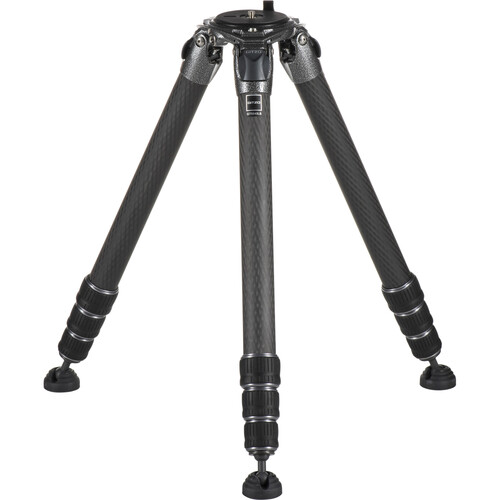
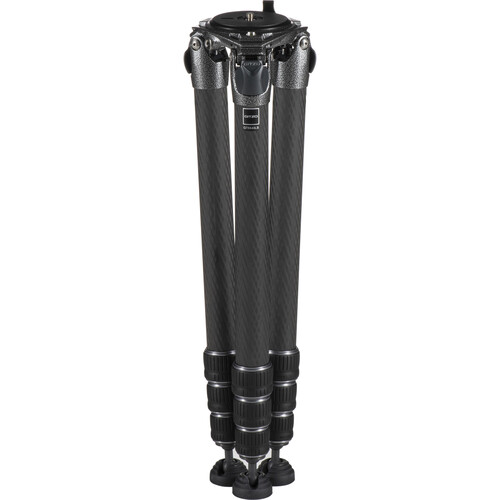
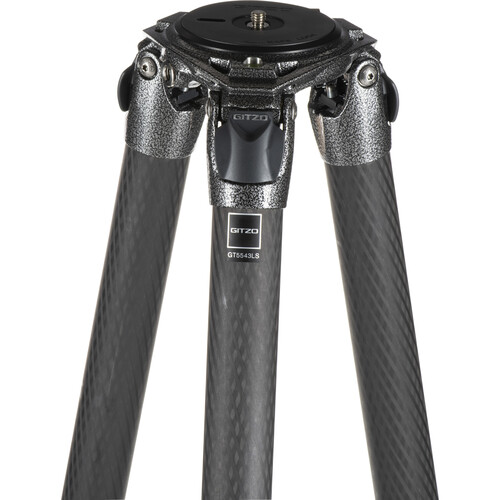
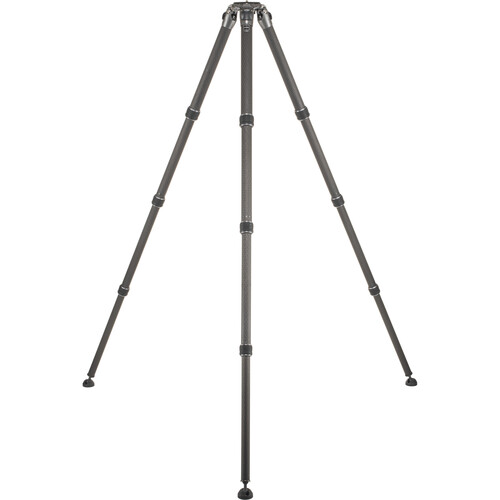
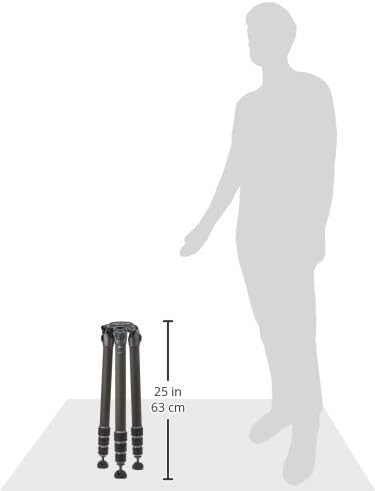
Best Use
Wildlife and bird photography with large super-telephoto lenses. Perfect for pros or serious hobbyists using gimbals and high-end gear.
2) Manfrotto MT055CXPRO3: Versatile Performance in a Lightweight, Field-Friendly Package
Why it’s Great for Wildlife Photographers
The MT055CXPRO3 Carbon Fiber Tripod with XPRO Magnesium Ball Head Kit from Manfrotto pairs the MT055CXPRO3 Carbon Fiber Tripod with the XPRO Magnesium Ball Head with the MSQ6PL Quick Release Plate giving you smooth, precise control for tracking wildlife or locking into a steady composition.
For wildlife photographers who want a versatile, lightweight setup without compromising on performance, the Manfrotto MT055CXPRO3 hits a sweet spot. It’s sturdy enough to support long lenses while remaining compact and easy to carry, making it great for day hikes, forest trails, or quick roadside stops.
Designed for Flexibility
The standout feature is its 90° center column mechanism, which allows you to switch from vertical to horizontal in seconds, perfect for low-angle ground shots or creative macro work in the wild.
A redesigned center column has a “one finger” operation and includes an Easy Link 3/8″-16 attachment for attaching accessories such as an LED light or a reflector via a compatible arm.
The upper disc where a tripod head is mounted has been redesigned as well and now has a bull’s eye bubble level that rotates 360° so you can locate it where you can see it. This allows you to level your camera on both the horizontal and vertical planes.
It’s not built for the heaviest setups like the Gitzo Series 5, but for mid-range telephoto lenses (like a 100-500mm or 300mm f/4), this tripod delivers excellent stability, speed, and portability.
Key Features:
- Build: Carbon fiber legs with magnesium components for weight savings and strength
- Weight Capacity: Supports up to 19.8 lbs (9 kg)
- Max Height: 66.9 in (170 cm) with center column extended
- Folded Length: 24 in (61 cm)
- Weight: 5.5 lbs (2.5 kg) with ball head included
- Leg Sections: 3-section legs with easy-to-use Quick Power Locks
- 90° Center Column: Instantly switches to horizontal for low-angle or overhead shots
- XPRO Magnesium Ball Head: Fluid movement with adjustable tension and quick-release plate (200PL)
- Head Mount Type: 3/8″-16 Male
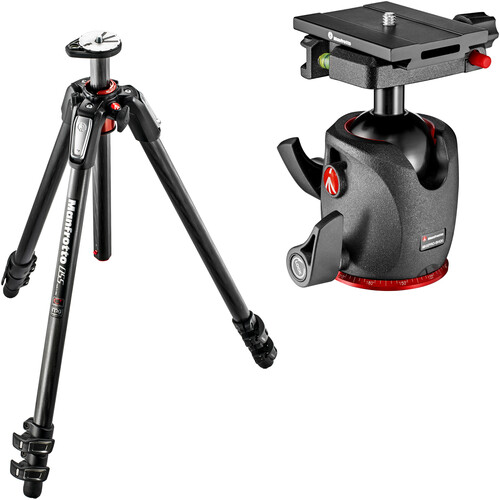
XPRO Magnesium Ball Head
- 33.1 lb load capacity
- Compatible with tripods or support systems that feature a 3/8″-16 mount
- Uses ball-and-socket joint to help maximize pan-and-tilt flexibility
- Ball-and-socket joint provides 360° of swivel control, is tiltable down to a 90° angle, and can be locked into place
- Integrated Arca-type clamp on top of on the ball-and-socket joint is compatible with Arca-type quick-release plates
- Primary locking knob allows ball-and-socket joint to be quickly swiveled, angled, fully tilted, or returned to its upright position
- Secondary locking knob allows head to rotate 360°
- Dedicated tension control knob for the ball-and-socket joint’s movements
- Two bubble levels for landscape orientations and one bubble level for portrait orientations
- Durable, magnesium-alloy construction
MSQ6PL Quick Release Plate
- Compatible with Arca-type quick release clamps
- Measures 2.8 x 2.2 x 0.4″
- 1/4″-20 mount
- Durable, aluminum-alloy construction
- UPC: 719821378303
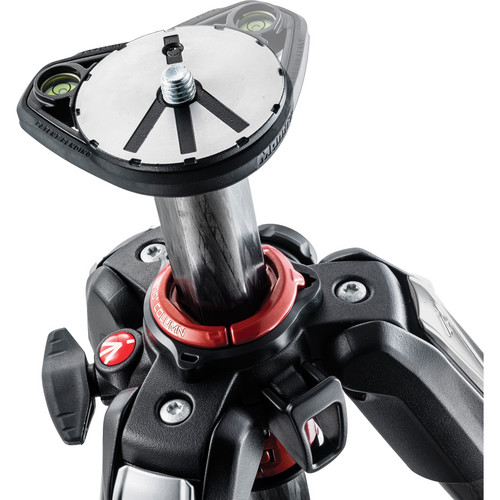
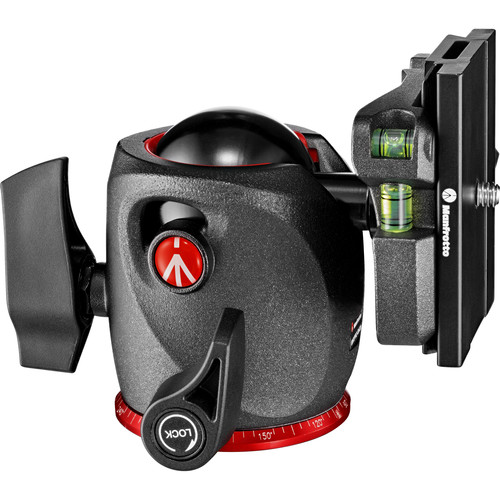
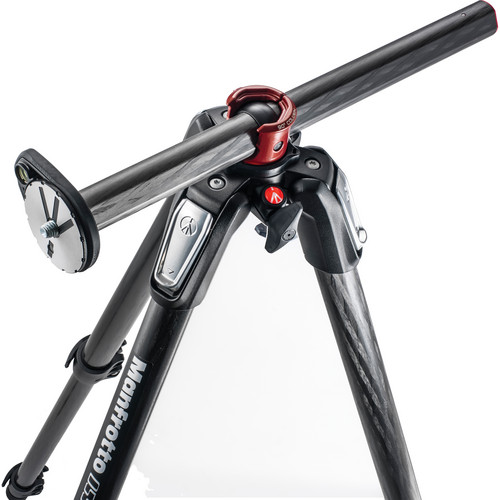
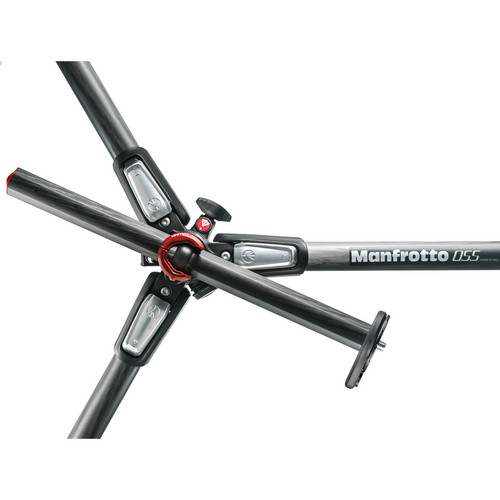
Best Use
Wildlife and nature photography with mid-sized DSLR or mirrorless systems and telephoto zooms. A great all-around field tripod for both stills and occasional video work.
3) Really Right Stuff TVC-34L Versa Series 3 Mk2: Rugged Precision for Serious Wildlife Shooters
Why it’s Great for Wildlife Photographers
The Really Right Stuff TVC-34L Mk2 delivers bulletproof stability and precision engineering that serious wildlife photographers swear by. The Mk2 updates improve upon an already beloved design with enhanced twist-locks, better ergonomics, and a more modular apex for added flexibility in the field. It’s built to eliminate flex, vibrations, and instability—no matter the lens or the weather.
Built to Last (and Then Some)
Crafted from RRS’s patented carbon fiber weave, this tripod supports up to 50 lb of gear while weighing just 4.7 lb itself. The 4-section legs extend to a generous 68.8″ max height and collapse to a minimum working height of just 4″, giving you the versatility to shoot from nearly any angle.
Ideal for Demanding Conditions
Whether you’re perched on a rocky cliff, wading in a marsh, or shooting from a windy ridge, the TVC-34L stays planted and lets you focus on the shot. It’s not the most compact or lightweight tripod, but that tradeoff brings peace of mind: your gear is secure, and your image is sharp.
This is the kind of tripod you buy once—and count on for a lifetime of fieldwork.
Key Features:
- Made in USA: Precision-engineered in Utah with tight tolerances and premium materials
- Build: 100% carbon fiber legs, CNC-machined aluminum hardware
- Weight Capacity: 50 lbs (22.7 kg)
- Max Height: 68.3 in (173.5 cm)
- Folded Length: 24.4 in (62 cm)
- Weight: 4.8 lbs (2.2 kg)
- Leg Sections: 3-section legs with improved twist locks
- Modular Apex: Compatible with RRS accessories, including leveling bases and center columns
- Rubber Ball Feet provide a non-slip grip on surfaces and can be switched to metal “all-terrain” spikes, which are available separately
- Twist locks with integrated wipers to keep particles out of the locking mechanism
- Versa apex which accepts a 75mm video bowl, has multiple 1/4″-20 sockets for accessories
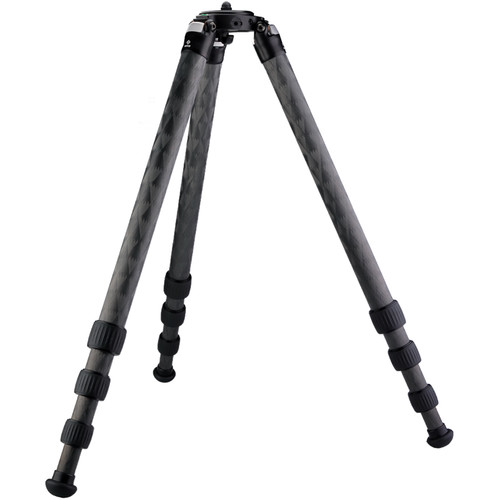
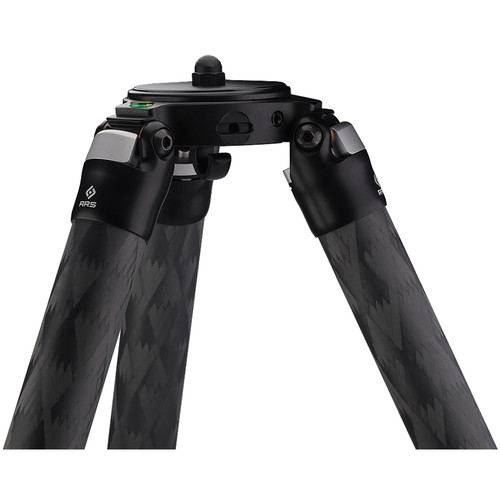
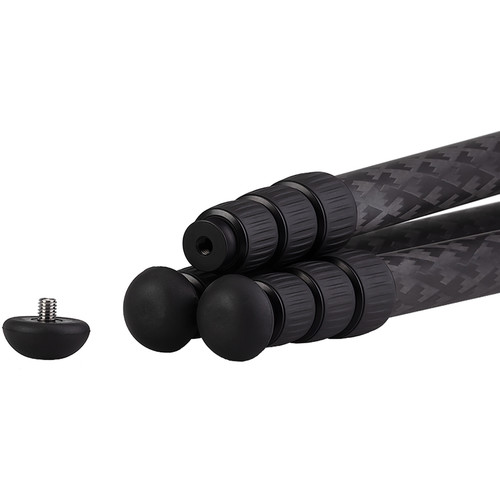
Best Use
Wildlife photography with long telephoto lenses in rugged, uneven terrain. Ideal for those who prioritize ultimate stability and long-term durability over portability.
4) Sirui W-2204 Waterproof Carbon Fiber Tripod
Why it’s Great
Wildlife photography isn’t always sunshine and singing birds—sometimes it’s rain, mist, riverbanks, and marshy trails. The Sirui W-2204 is designed for those exact situations. Its waterproof and dust-resistant leg sealing system prevents moisture, grit, and debris from entering the leg tubes, making it a top pick for nature photographers who venture into wet and rugged terrain.
Durable and Reliable in the Field
While it might not be as heavy-duty as the Gitzo or Really Right Stuff models, the W-2204 holds its own with impressive durability and excellent value, especially for its price point. This tripod is built to survive tough conditions without weighing you down.
Versatile Height and Load Capacity
With 4-section legs and smooth twist locks, the tripod extends to a maximum height of 70.9″, holds up to 39.7 lb, and weighs just 3.7 lb—making it sturdy enough for telephoto lenses while remaining portable for long hikes or travel.
Built-In Monopod for Quick Mobility
One standout feature: one of the legs can be removed and attached to the center column to create a full-sized 69.7″ monopod. This makes it perfect for situations where agility and fast repositioning are key. The reverse-folding legs allow the tripod to fold down to a compact 20.5″, making it easy to carry and pack.
Adaptable Feet for Any Terrain
Whether you’re on soft soil, icy paths, or rocky trails, the tripod stays stable. Its rubber feet can be swapped out for stainless-steel spikes, offering solid footing in a wide range of outdoor environments.
Key Features:
- Build: 10-layer carbon fiber legs, waterproof twist leg locks
- Weight Capacity: 39.6 lbs (18 kg)
- Max Height: 70.9 in (180 cm)
- Folded Length: 20.5 in (52 cm)
- Legs fold up 180° for extra compactness.
- Weight: 3.7 lbs (1.7 kg)
- Leg Sections: 4
- Integrated Monopod: One leg detaches for monopod use
- Waterproof Seals: Keeps out water, sand, and dust—ideal for beaches, streams, or swamps
- Reversible Center Column: For low-angle or macro work
- .Ergonomic leg angle locks for fast adjustment – even with wet or gloved hands.
- Leg converts into a waterproof monopod.
- Bubble level for fast horizontal alignment.
- Hook under the center column can hold a weight bag for added stability.
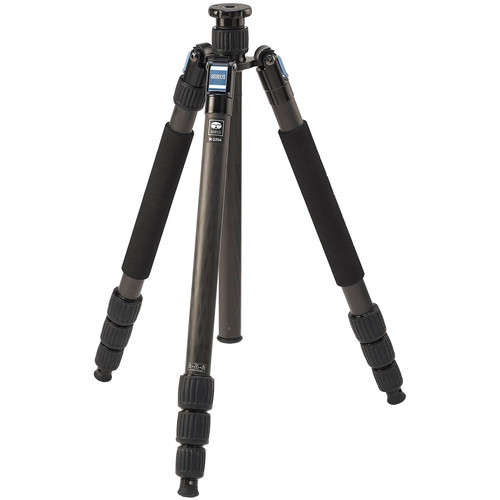
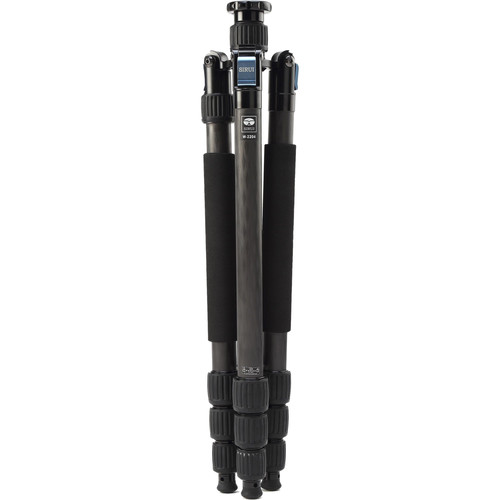
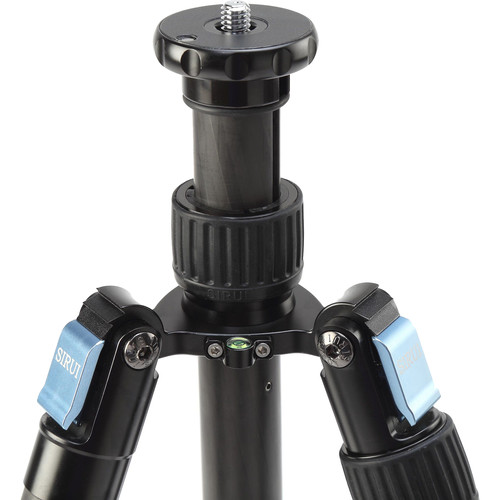
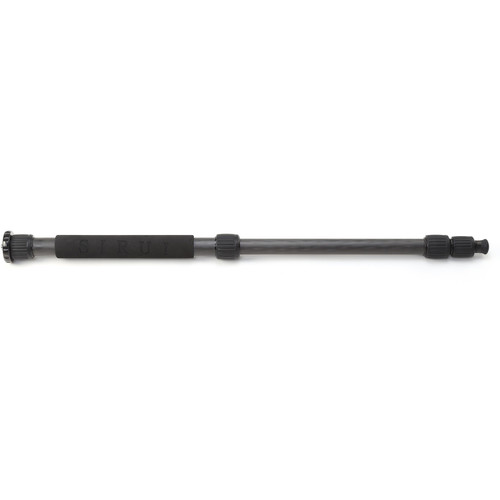
Best Use
Bird and wildlife photography in wet, coastal, or muddy environments. Great for photographers who want versatility, durability, and protection from the elements without breaking the bank.
5) Sirui CT-3204 Explorer Series Carbon Fiber Tripod with CH-20 Gimbal Head
Why it’s Great for Wildlife Photographers
The Sirui CT-3204 Explorer Series Carbon Fiber Tripod with CH-20 Gimbal Head is a rugged and reliable companion for wildlife photographers who need strength, stability, and stealth in the field. Its camo pattern blends naturally into outdoor environments, making it ideal for shooting elusive wildlife without drawing attention.
Lightweight Yet Strong
Constructed with a blend of carbon fiber and aluminum, this tripod strikes a smart balance between strength and portability. It weighs just 7.3 lb, yet supports a hefty 44.1 lb of gear—perfect for long lenses and heavy camera setups. And when the shoot is done, it conveniently folds down to 30.5” with the gimbal head attached, making it travel-friendly.
Flexible Leg Design and Monopod Option
The 4-section legs are independently adjustable, allowing you to adapt quickly to uneven terrain. Twist locks keep everything secure during setup and breakdown. For added versatility, one leg detaches and pairs with the center column to convert into a full-length 69.7” monopod—ideal for situations that demand mobility or rapid repositioning.
Adaptable to Every Terrain
To enhance stability across different surfaces, the tripod features removable rubber feet that can be swapped out for stainless-steel spikes—giving you sure footing on everything from gravel to mud. When shooting low to the ground, the split center column allows the tripod to reach a minimum height of just 6.1”. For windy conditions or uneven ground, the built-in ballast hook lets you hang a weight to keep things steady.
Key Features:
- Tripod Build: 10-layer carbon fiber with camo finish
- Weight Capacity: 55 lbs (25 kg)
- Max Height: 63 in (160 cm)
- Folded Length: 22.8 in (58 cm)
- Tripod Weight: 4.6 lbs (2.1 kg)
- Leg Sections: 4
- Feet: Interchangeable rubber and stainless steel spikes
- Features: Converts into a monopod, water-resistant twist locks.
- Included Head: CH-20 gimbal head—smooth tracking, Arca-Swiss compatible, and compact
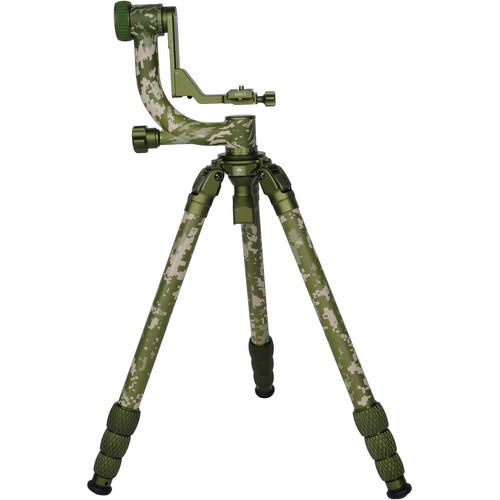
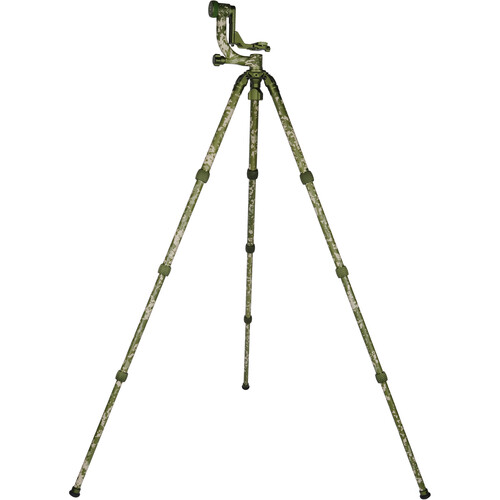
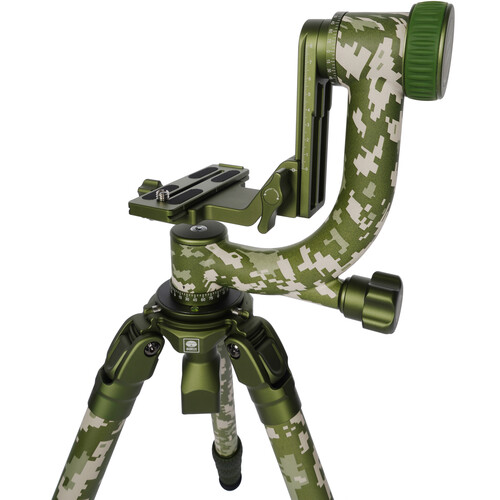
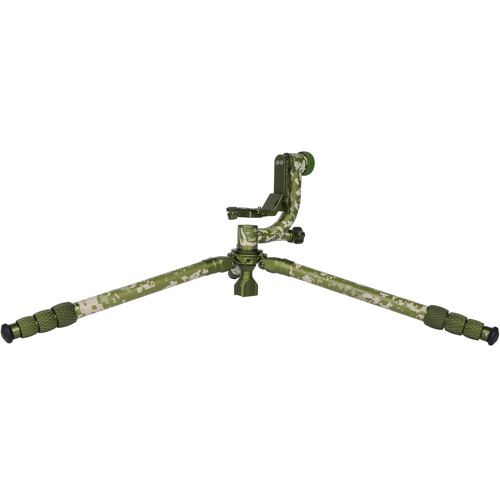
Best Use
Wildlife and bird photographers who need a rugged, mobile, stealthy support system for long days in the field.
6) Leofoto LN-404C Heavy Duty Tripod with 100mm Bowl, Platform & Bag
Why it’s Great for Wildlife Photographers
If you’re hauling super-telephoto lenses into wild terrain and need a no-compromise support system, the Leofoto LN-404C is built for the job. It’s the tripod you reach for when stability is non-negotiable – whether you’re on uneven ground, battling the wind, or waiting for wildlife to emerge at a distance.
Built for Brutal Conditions
This tripod is part of Leofoto’s Mountain Series and it shows. With 10-layer Torayca carbon fiber legs and CNC-machined 6061/7075 aluminum components, the LN-404C is rugged without being overly heavy. It’s engineered to take a beating and keep going – perfect for long-term field use in harsh environments.
Strength Meets Height
Need to shoot over tall grass, deep snow, or rocky ledges? No problem. The LN-404C offers impressive max height and rock-solid performance under pressure. It can handle the weight of the heaviest super-tele lenses and still stay steady on soft or sloped terrain.
Designed for Video and Still Photography
The tripod’s apex includes a 100mm video bowl adapter that accommodates standard half-ball video heads – ideal for wildlife videographers or those using gimbals. A smart safety release button prevents the top plate from accidentally dropping out, keeping your gear safe.
Field-Ready Features
Practical touches like a strap screw ring for easy carrying and interchangeable feet (rubber or stainless-steel spikes) make it versatile on any surface – whether you’re trekking over icy paths, muddy banks, or rocky trails. It’s not just a tripod; it’s a heavy-duty field companion.
Key Features:
- LN-404C Tripod:
- Max. height: 1910mm / 75.20in
- Min. height: 115mm / 4.53in
- Folded length: 700mm / 27.56in
- Leg Section: 4
- Max load: 50kg / 110.23lb
- Weight: 3.40kg / 7.50lb
- Bowl diameter: 100mm / 3.94in
- Leg tube sizes: 40/36/32/28mm
- DC-404C Center Column:
- Tube diameter : 32mm/ 1.26in
- Length : 425mm/ 16.73in
- Weight : 510g/ 1.12lb
- Included Interchangeable 100mm Video Bowl & 100mm Platform
- 3/8″ Mounting Stud on 100mm Platform
- Independent Leg Spread
- Three Angle Stops: 23-, 55-, and 85°
- Interchangeable Feet (3/8″)
- Carrying Case
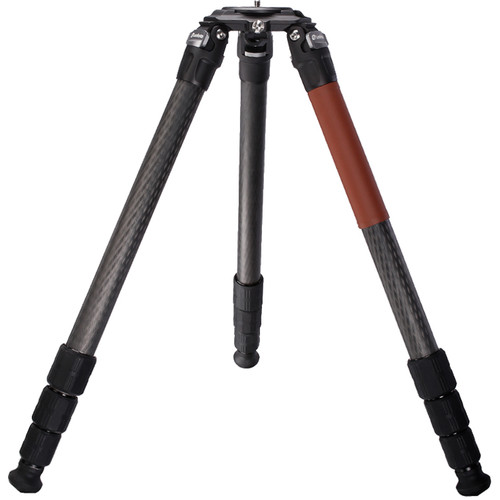
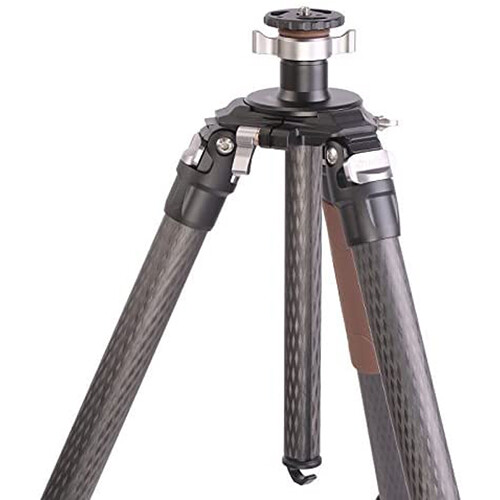
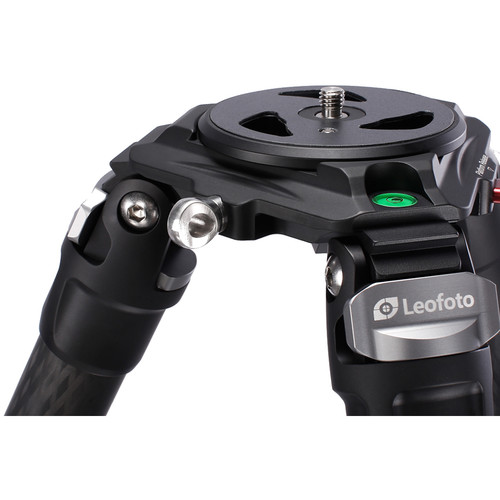
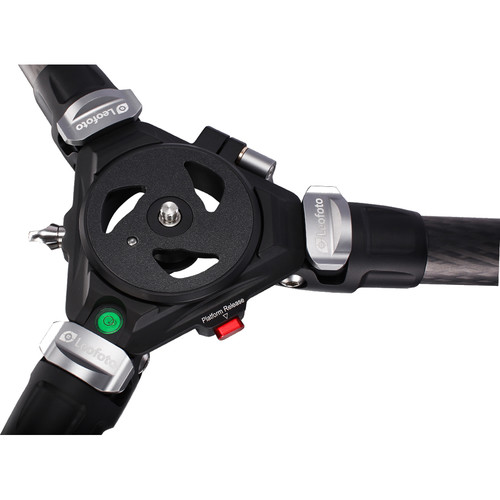
Best Use
Wildlife photographers using long telephoto primes in tough, mountainous, or off-road environments.
7) TR424L ProMediaGear Pro-Stix 77″ 4-Section Carbon Fiber Long Tripod with Top Plate
Why it’s Great for Wildlife Photographers
The TR424L Pro-Stix is a powerhouse. Built in the USA with premium materials, this tripod is tailored for photographers who push their gear to the limit. Whether you’re photographing big game on safari, setting up in arctic wind, or covering remote landscapes with heavy super-telephoto lenses, this tripod delivers uncompromising performance.
Built to Handle Anything
Supporting up to 125 lbs, this tripod is overkill in the best way possible. Its carbon fiber legs are thick and stable, and the CNC-machined aluminum apex is designed for strength and long-term durability. With this much capacity, it’s rock solid even with the bulkiest gear setups.
Adjustable, Versatile, and Field-Ready
- Max Height: 77″
- Min Height: 6.7″
- Folded Length: 26.3″
- Leg Diameter: 42mm
- Weight: Durable yet manageable
The four-section legs offer independent spread and feature three-position angle locks and quarter-turn twist locks for fast setup. Rubber feet come standard, but can be swapped for stow-away metal spikes—ideal for uneven or soft terrain.
Smart Mounting Options
The included top plate features a standard 3/8″-16 mount for attaching heads, cameras, or optics. A cam lock with push-button release keeps your gear secure. The truss-style apex reduces weight while maintaining strength.
For videographers or users who prefer leveling options, you can upgrade with:
- TRBU75 75mm Leveling Base
- TRB75 Tripod Bowl Insert
These allow you to level your video head without adjusting the legs.
Customization and Accessory Support
The tripod features eight 1/4″-20 accessory threads:
- One on the underside of the top plate
- Four around the head
- Two on each leg hinge
These accommodate ProMediaGear accessories (or standard accessories with anti-twist pins), giving you options for mounting monitors, arms, or even extra support gear.
Key Features:
- Head Mount Type 3/8″-16 Male
- Design: Wide stance, anti-slip rubber feet, stainless spikes included
- Build: 42mm 10x carbon fiber legs, CNC-machined apex
- Weight Capacity: 125 lbs (56.7 kg)
- Max Height: 77″ / 195.6 cm
- Folded Length: 26.3″ / 66.8 cm
- Weight: 6.4 lb / 2.9 kg
- Leg Sections: 4
- Leg Positions: 3 Positions
- Leg Lock: Twist Lock
- Top Plate: Interchangeable with leveling base or video bowl
- Foot Features: Spiked, Removable
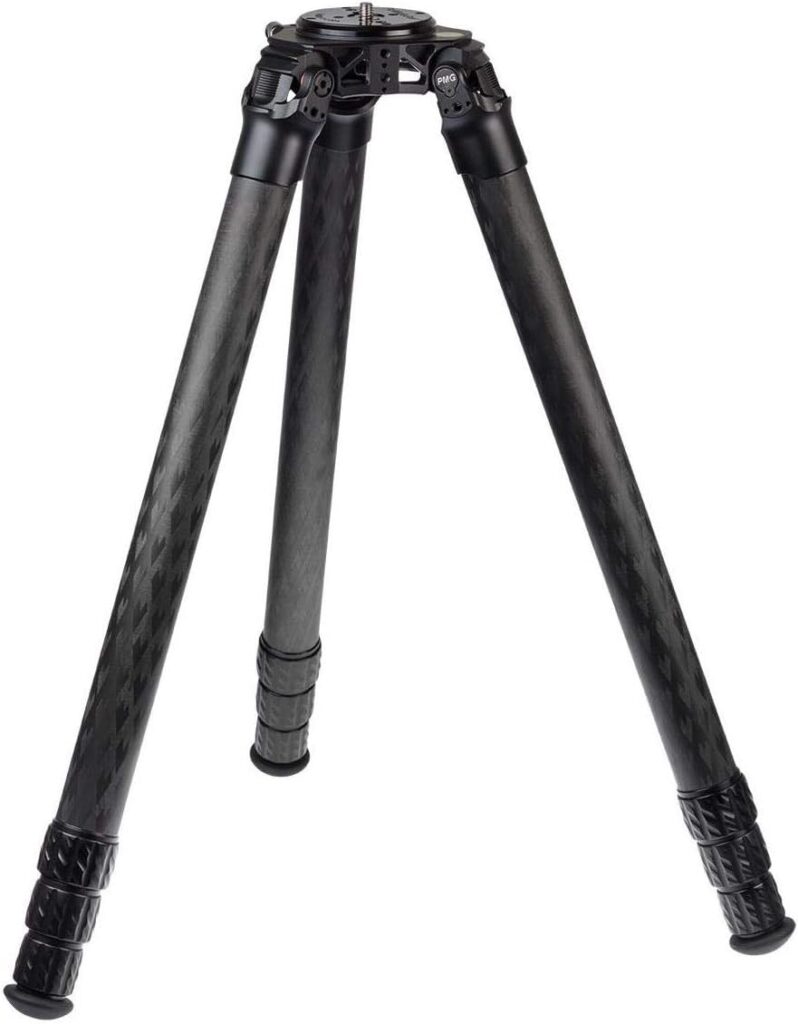
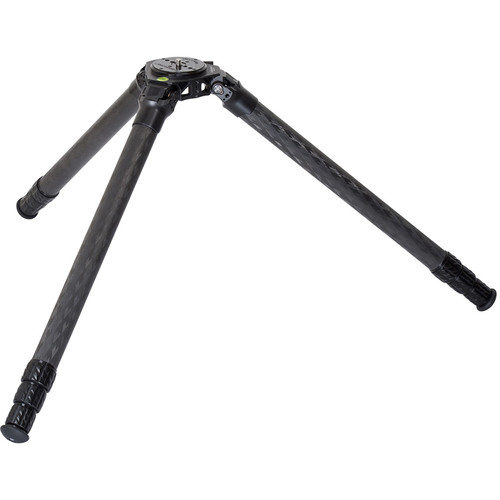
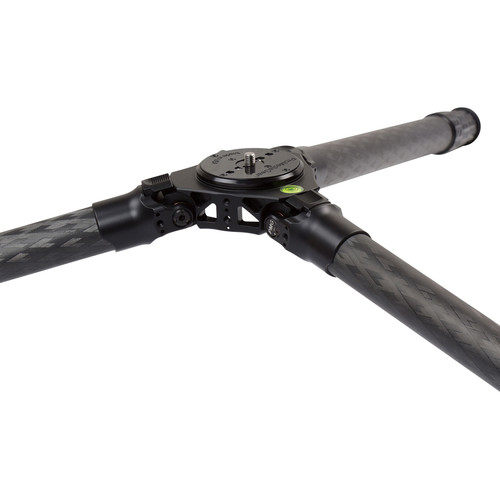
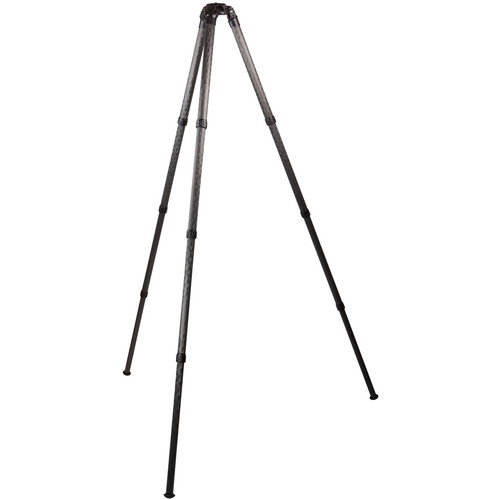
Best Use
Hardcore wildlife pros using 600mm or 800mm lenses in extreme environments.
8) Feisol Elite CT-3472 Rapid Carbon Fiber Tripod
Why it’s Great for Wildlife Photographers
Feisol doesn’t get as much love as the big brands, but the CT-3472 Elite has long been a favorite among photographers who want maximum performance without emptying their wallets. It offers an impressive 55 lb load capacity while remaining surprisingly light for its size.
The Elite Tripod CT-3472 M2 from Feisol is constructed using CNC milled 6061-T6 aluminum and high-grade carbon fiber legs that make the tripod a lightweight 3.9 lb. Also, by unlocking the twist locks, the 4-section tripod can reach a maximum height of 57.9″, and with the 3 variable leg angles of 25, 50, and 75°, the support can go as low as 3.4″.
Meanwhile, Feisol’s Rapid anti-leg rotation technology does not allow the legs to twist when fully extended. Because of the 66 lb weight capacity, the tripod supports mirrorless to large format cameras for professional applications.
Additionally, the legs fold 180° in reverse, which makes it a compact 20.5″, and the built-in bubble level ensures that your horizon is aligned every time.
Its rapid anti-rotation leg locks are smooth and secure, and the tripod is tall enough for most photographers to use without hunching over. Whether you’re hauling gear into the backcountry or shooting along steep ridgelines, this one gives you pro-level stability without the Gitzo price tag.
Key Features:
- Feet: Rubber feet with spike option for rough terrain
- Build: Carbon fiber legs with anti-slip twist locks
- Weight Capacity: 66 lbs (30 kg)
- Max Height: 57.9 in (147 cm)
- Folded Length: 20.5 in (57 cm)
- Weight: 4.3 lbs (1.95 kg)
- Leg Sections: 4
- Integrated bubble level at the yoke of the tripod
- CNC milled 6061-T6 aluminum with carbon fiber legs make it lightweight and weighing 3.9 lb
- Twist locks with Rapid anti-leg rotation technology
- Variable leg angles of 25, 50, and 75°
- Center Column: Optional add-on for extra height
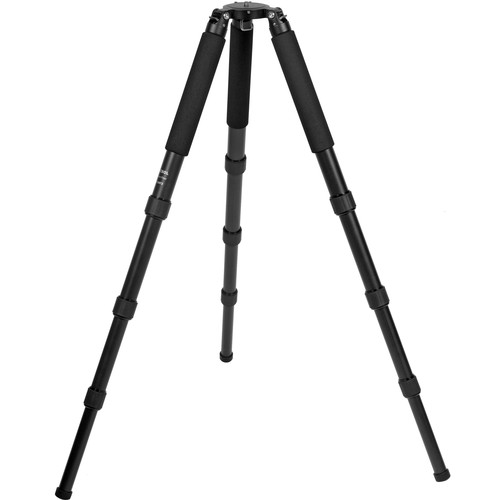
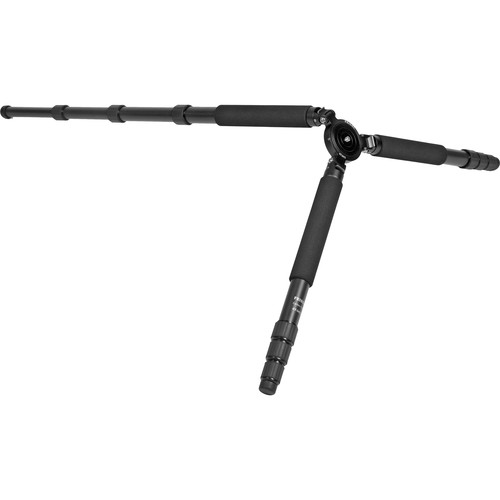
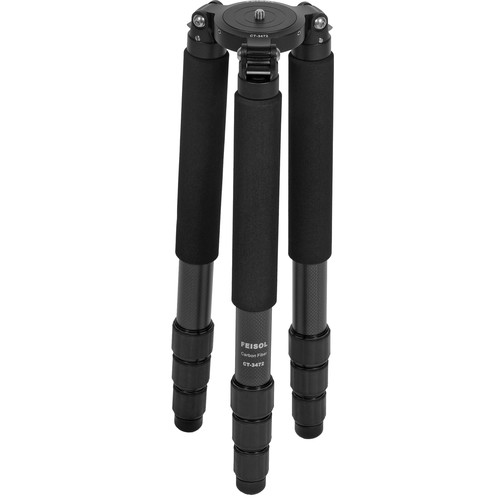
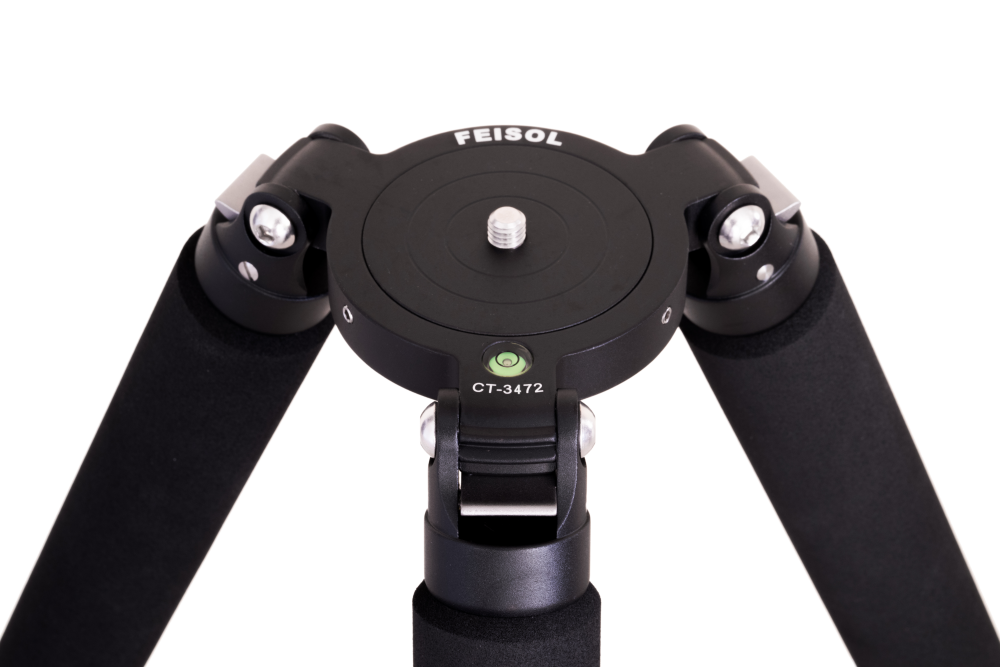
Best Use: Long treks and wildlife shoots where lightweight but strong support is key.
9) Leofoto LS-324CX+LH-40LR Travel Tripod, Ranger Series, Carbon Fiber, 4 Leg Sections, Lightweight, Ball Head Set
Why it’s Great for Wildlife Photographers
If you need a tripod that can keep up with your wanderlust without weighing you down, the Leofoto LS-324CX + LH-40LR from the Ranger Series is a solid choice. This lightweight yet rugged carbon fiber travel tripod punches way above its weight, offering rock-steady support for wildlife photographers on the move.
Built with 10-layer carbon fiber and aircraft-grade aluminum components, it’s tough enough for rough conditions while still collapsing down small enough to strap to a backpack. The four-leg section design gives you a great balance of height and portability, and the twist-lock system makes setup fast and smooth—even with gloves on.
The included LH-40LR low-profile ball head delivers silky-smooth movements and includes a lever-release clamp for quick camera adjustments—a bonus when seconds count and your subject could bolt at any moment.
Whether you’re hiking deep into remote terrain or just need a versatile everyday tripod for birding and wildlife, this compact workhorse won’t slow you down.
Key Features:
- Included LH-40LR Ball Head w/ Lever Release Clamp and Camera Plate.
- Included DC-282C Center Column, Length: 7.8-12.5in
- Max. Height w/ Center Column: 1820mm / 71.65in
- Max. Height: 1500mm / 59.06in
- Min. Height: 180mm / 7.09in
- Folded Length: 600mm / 23.62in
- Leg Section: 4
- Tubes: 32/28/25/22
- Max load: 15kg / 33.07lb
- Weight: 1.88kg / 4.14lb
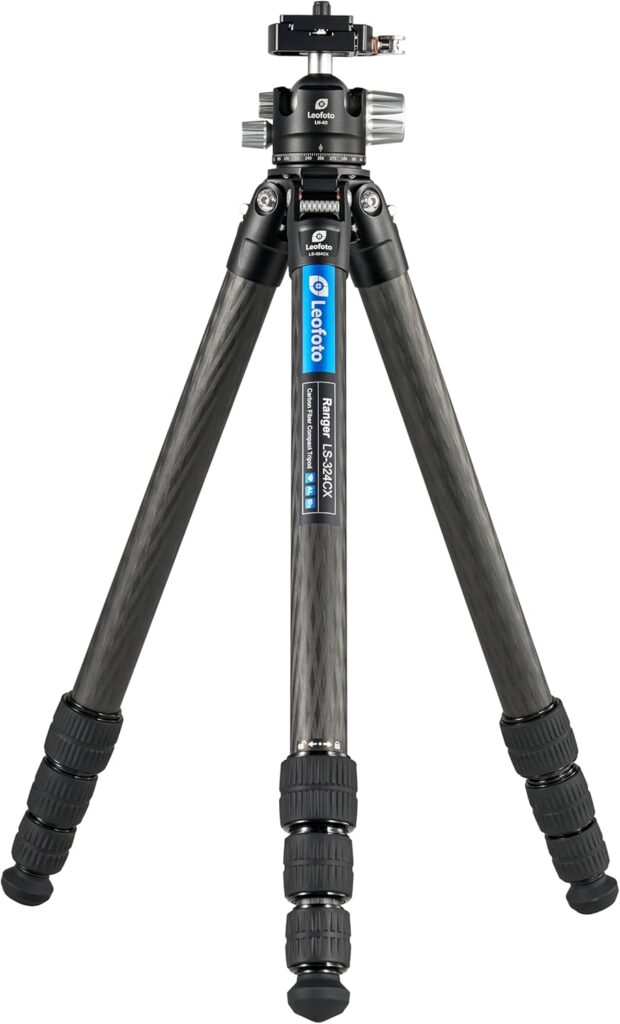
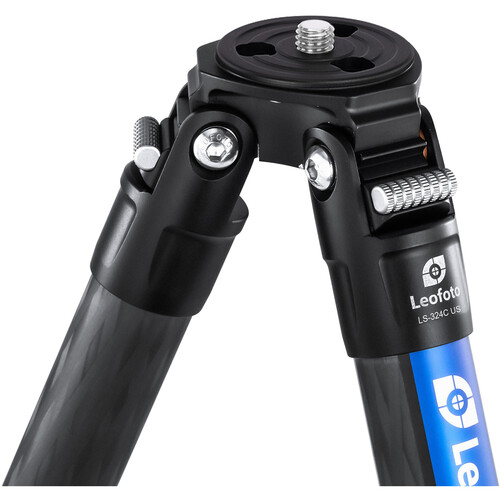
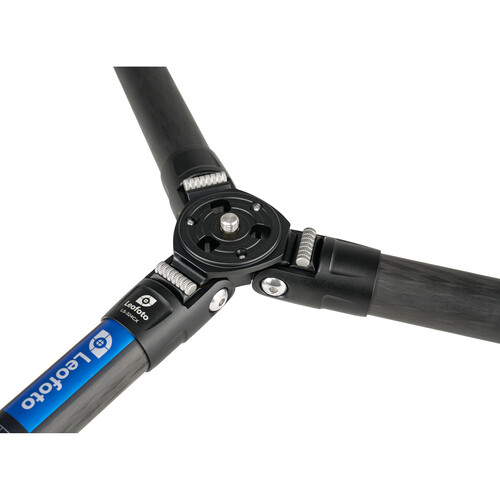
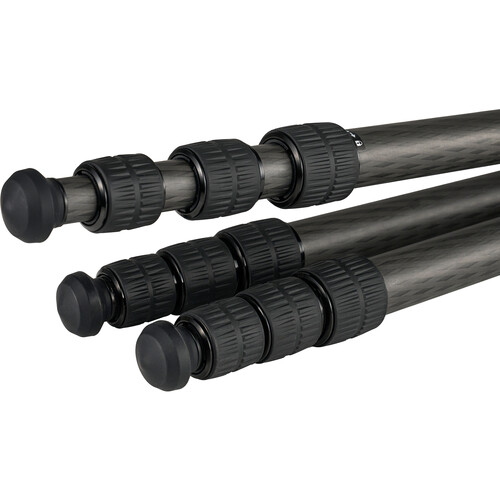
Best Use
Lightweight travel setups that still demand gimbal use and lens stability in the field.
Buy from B&H (without Ballhead)
Buy from Amazon (With and without Ballhead)
10) Leofoto LS-284CEXX Travel Tripod w/Built-in Leveling Head, Ranger Series
Why it’s Great for Wildlife Photographers
This one replaces the Benro Mach3 as a better beginner-to-intermediate option for wildlife photographers. The Leofoto LS-284C is a compact, no-nonsense tripod that’s easy to carry and quick to set up. It holds more weight than you’d expect for its size, and its simple, center-column-free design keeps things stable.
Perfect for lighter camera bodies and shorter lenses, or as a secondary tripod when you’re on the move. The build quality and twist locks feel premium for the price point, making it a smart investment for new wildlife shooters who want to grow into their gear.
Key Features:
- Center Column: None – adds to overall stability
- Build: Carbon fiber with rubber twist locks
- Weight Capacity: 22 lbs (10 kg)
- Feet: Interchangeable rubber and spikes
- Working Height Range: 3 to 64.6″
- Folded Length: 18.7″
- Detachable Center Column: 7.8 to 12.5″
- Carbon Fiber Leg Sections: 4
- Angled Leg Positions: 23, 55, and 85°
- Twist Leg Locks
- Detachable Feet
- Thread: 3/8″-16 & 1/4″-20 Screw, 1/4″-20
- Includes Carrying Case
- Weight: 2.8 lb
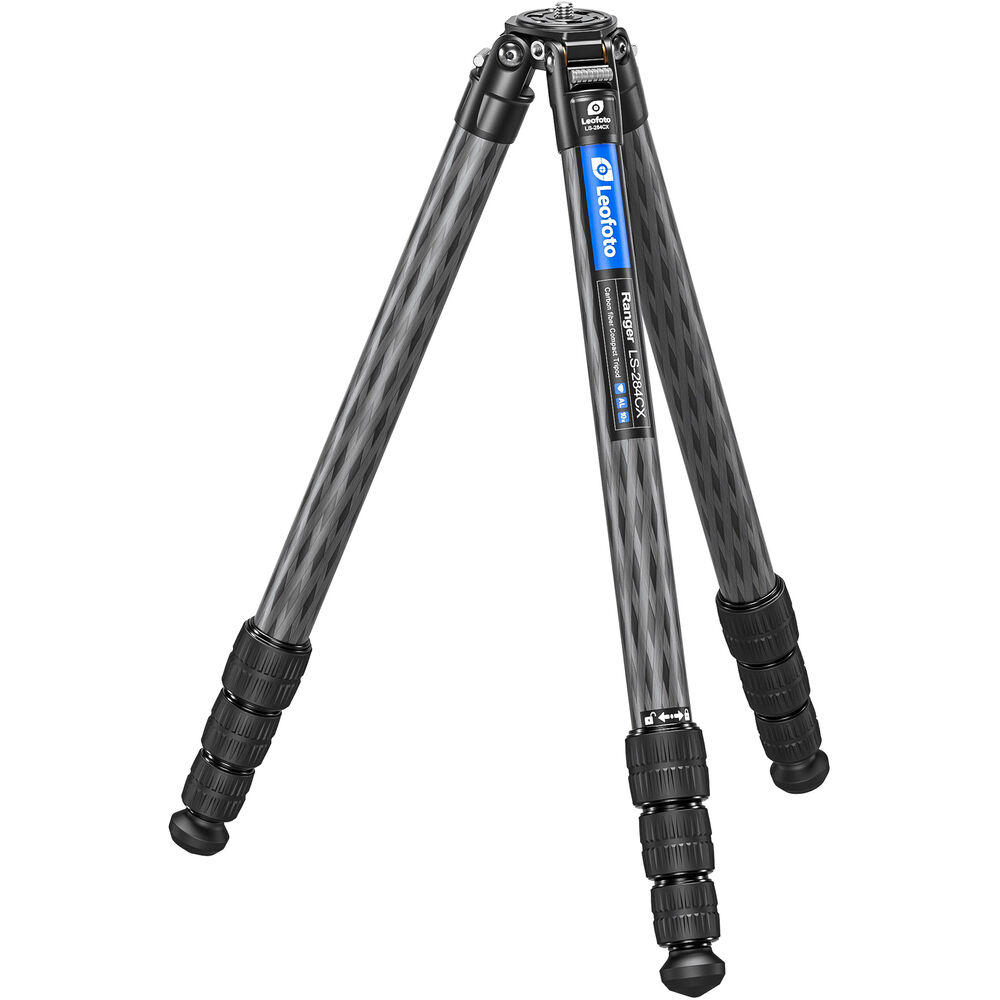
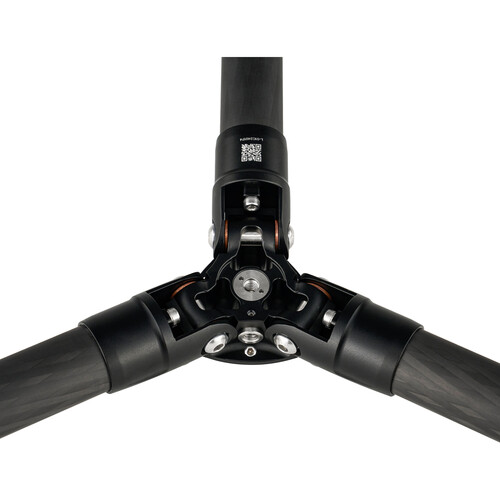
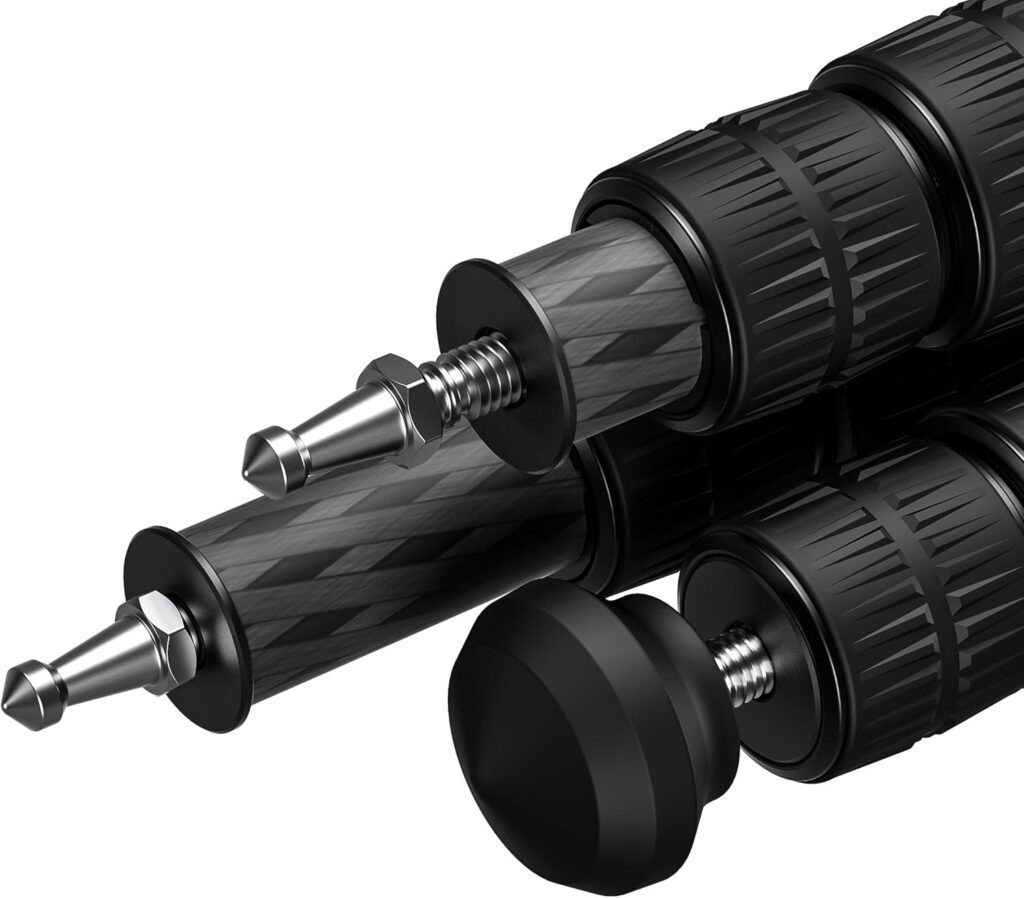
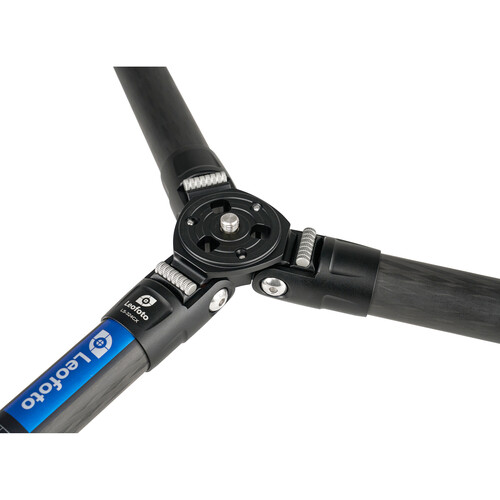
Best Use
Beginner wildlife photographers, lightweight setups, or backup tripod for travel.
Tripod & Support Guide: What to Know Before You Buy
Wildlife photography isn’t just about fast shutter speeds and long lenses – it’s also about keeping your camera rock-steady when that once-in-a-lifetime moment happens. Whether you’re trekking through alpine brush to photograph mountain lions or crouched near a Colorado riverbed at sunrise, the right support system – tripod, monopod, or otherwise – can be the difference between a tack-sharp masterpiece and a blurry regret.
Many seasoned wildlife photographers swear by tripods for a reason: they allow you to compose thoughtfully, wait patiently, and shoot precisely. Ever tried handholding a 600mm lens for more than a minute? It’s like arm-wrestling a boulder. Even with image stabilization, there’s a level of sharpness and consistency that only a tripod can provide – especially when you’re working with low light or slow-moving subjects like birds wading through water or a fox sniffing around your hide.
A good tripod isn’t just a piece of equipment – it’s your shooting partner. It holds the frame while you scan the horizon, keeps your composition locked when the animal finally steps into view, and spares your back and biceps after hours in the field. Sure, it might not fetch your coffee, but in the wild, it might just save your shot.
The key? Match your support gear to your photography style, terrain, and subject.
Top Factors to Consider
Terrain
If you’re shooting in rugged, uneven, or sloped environments, choose a tripod with independently adjustable legs and spiked or interchangeable feet for maximum stability.
Mobility
If your subject doesn’t stay still for long, or you’re covering lots of ground, a monopod might be your best bet – lighter, quicker, and easier to reposition on the fly. we will cover more detail about monopods and other support systems for wildlife photographers in another blog.
Gear Weight
Heavier camera bodies and super-telephoto lenses demand more robust support. Look for a tripod with high load capacity and rigid construction, especially for long hours in the field. The last thing you want is for a tripod to topple over because your camera and lens is too heavy for the tripod to support it.
Key Tripod Features to Look For
Material & Durability
For wildlife photographers, carbon fiber is the go-to. It’s strong, resistant to vibration, and much lighter than aluminum – perfect for long days in the field and rugged conditions.
Height & Load Capacity
Choose a tripod that can reach eye level without relying on the center column, which can compromise stability. Also, make sure it supports the total weight of your camera and lens—with a bit of margin for extra gear or unexpected conditions.
Head Compatibility
Tripods typically don’t include a head, so consider what you’ll pair it with:
- Gimbal heads for smooth tracking with heavy telephoto lenses
- Ball heads for quick adjustments and versatility
- Pan-tilt heads for precise framing and control
- Make sure the tripod’s mounting system supports your preferred head style.
We will feature the different types of tripod heads in another blog
Leg Locks & Stability
Look for reliable, weather-resistant locks.
- Twist locks are streamlined and sealed, great for wet or dirty environments.
- Flip locks can be faster and easier to handle, especially with gloves.
- Both can be stable—so go with what feels more natural in your workflow.
Portability & Weight
If you’re trekking or traveling, it’s especially important to consider tripods that collapse small and stay light. Moreover, a good wildlife tripod balances sturdiness with portability—helping you stay mobile without sacrificing stability. Additionally, bonus features like a carry case, strap loops, or removable feet (for spikes or snow baskets) can make a big difference when you’re navigating varied terrain.
Tripod Stone Bags
When shooting wildlife, even the slightest camera shake can ruin a once-in-a-lifetime shot. Tripod stone bags — small, durable hammocks that attach between your tripod legs — add crucial stability by allowing you to weigh down your setup with rocks, sandbags, or other heavy materials. Especially useful in windy conditions or on uneven ground, stone bags help keep your tripod firmly anchored, giving you sharper images and greater peace of mind when every moment counts.
FANAUE TS-01 Tripod Stone Bag: Lightweight Stability for Wildlife Photographers
The FANAUE TS-01 Tripod Stone Bag is a smart, lightweight solution for boosting tripod stability outdoors. Designed with adjustable buckles on all three straps, it easily fits a wide range of tripod types – from travel tripods to full-size studio models adapting to different leg angles for a secure fit.
Unlike hook closures, its buckle system improves load-bearing strength while the anti-slip design cuts down air resistance, making it ideal for windy conditions in the field. Crafted from premium nylon, the TS-01 is waterproof, abrasion-resistant, and tough enough to hold stones, sand, or even small gear like lens filters and battery chargers.
When not in use, it folds up compactly to fit into your camera backpack, adding almost no extra weight.
Specs:
- Material: High-quality nylon
- Weight: 0.3 lb
- Size: 8.66 × 5.51 × 1.57 inches
- Bonus: 30-day money-back guarantee with responsive customer service.
Whether you’re trekking through dense brush or battling gusty winds in open landscapes, the FANAUE TS-01 adds extra security to your setup — helping you stay focused on capturing that once-in-a-lifetime wildlife shot.
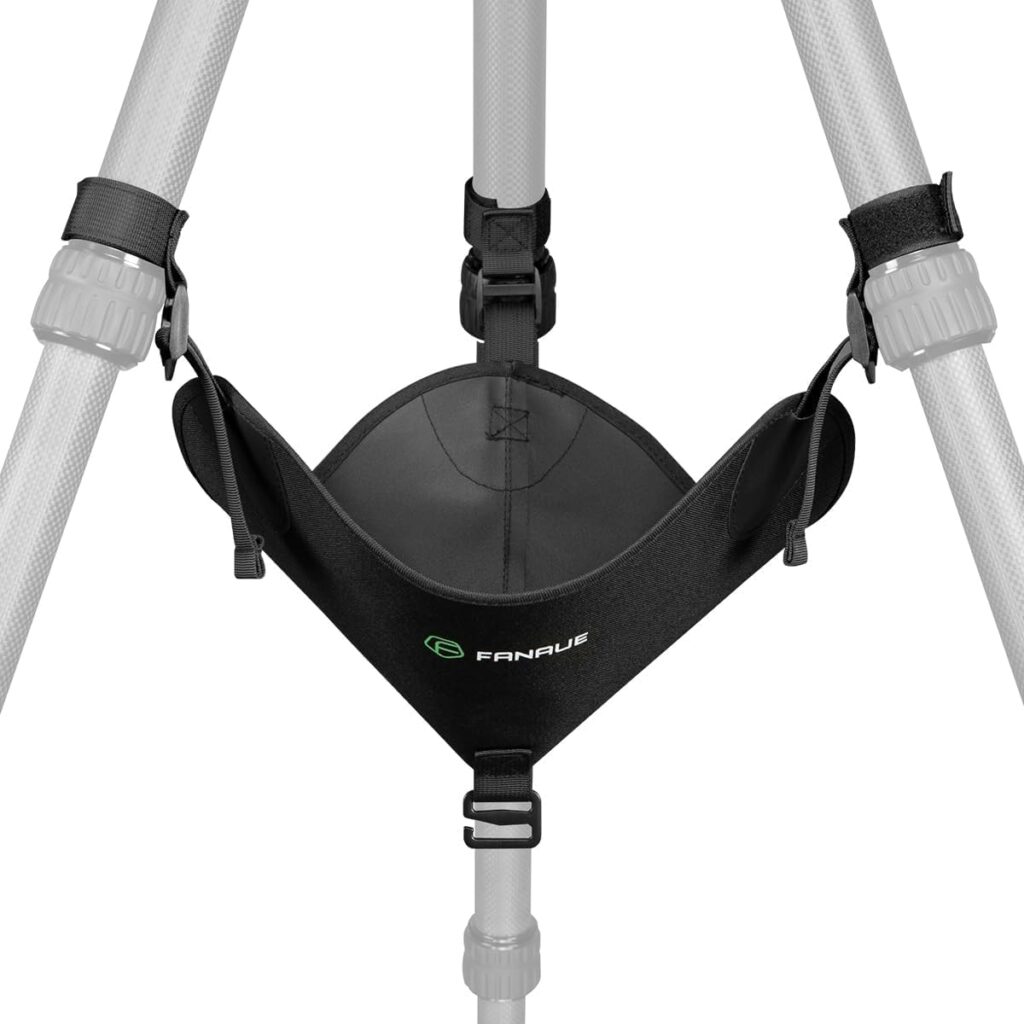
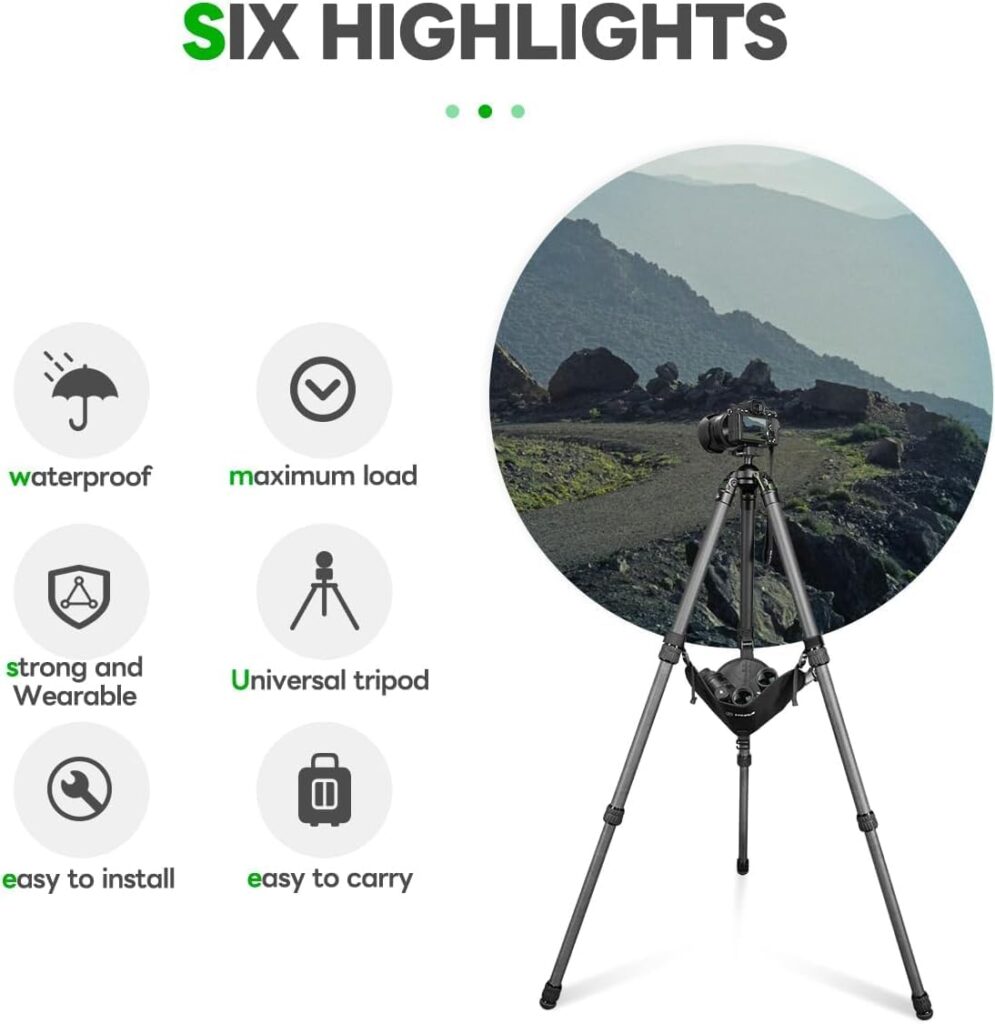
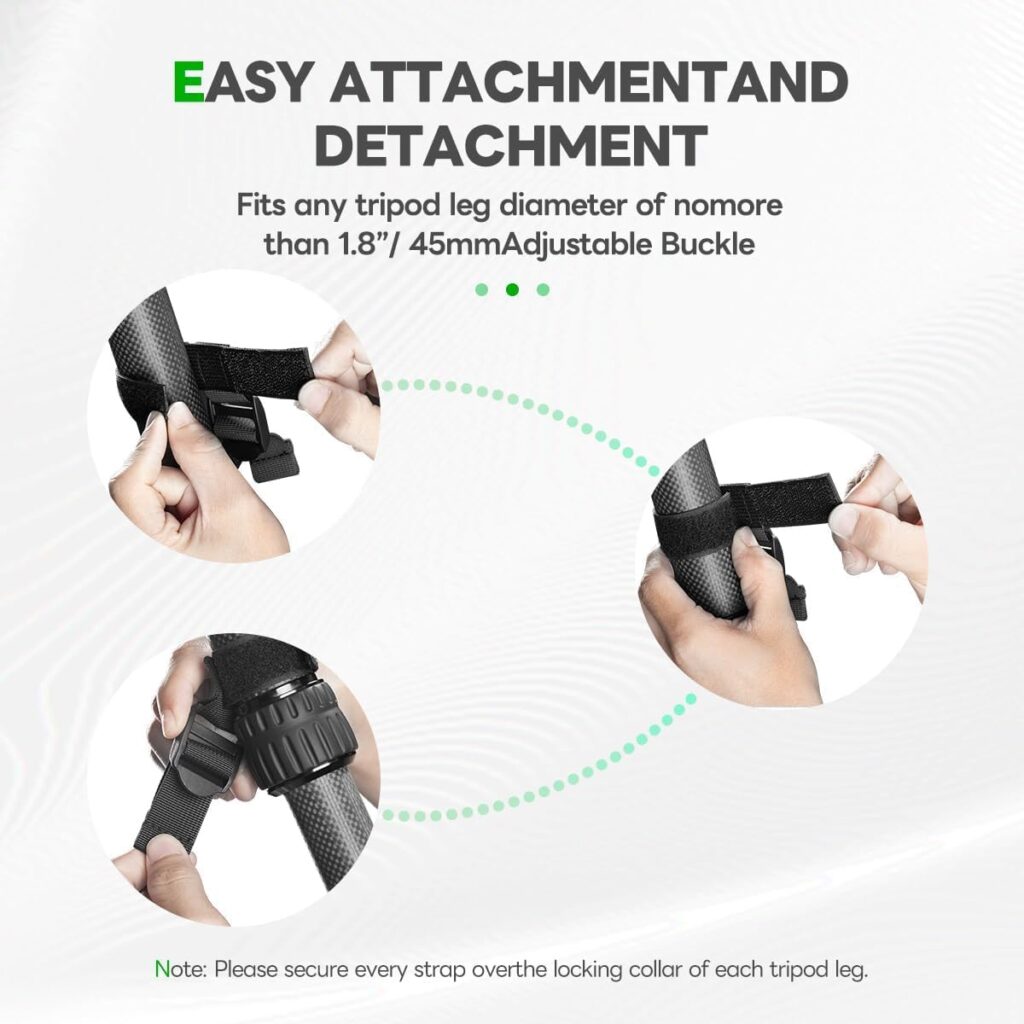
Vanguard SB-100 Stone Bag
When you’re working with a heavy camera and lens setup—or battling the wind out in the wild—the Vanguard SB-100 Stone Bag is an easy, effective way to boost your tripod’s stability.
Made from durable polyester, the SB-100 attaches quickly to any tripod with hook-and-loop fasteners, creating a secure platform for a counterweight like stones, sandbags, or even gear you already have on hand. By anchoring your tripod, it helps reduce camera shake and gives you a steadier shot in challenging conditions.
Key Features:
- Durable polyester construction
- Quick attachment with hook-and-loop fasteners
- Fits most tripods
- Helps stabilize heavy equipment or resist wind
Lightweight and compact, the Vanguard SB-100 is a smart addition to any wildlife photographer’s kit—especially when conditions are less than ideal.
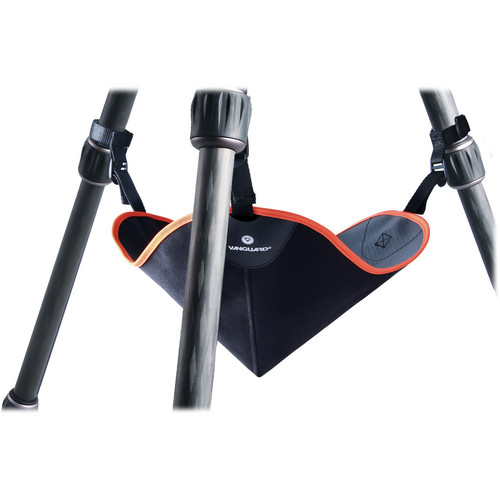
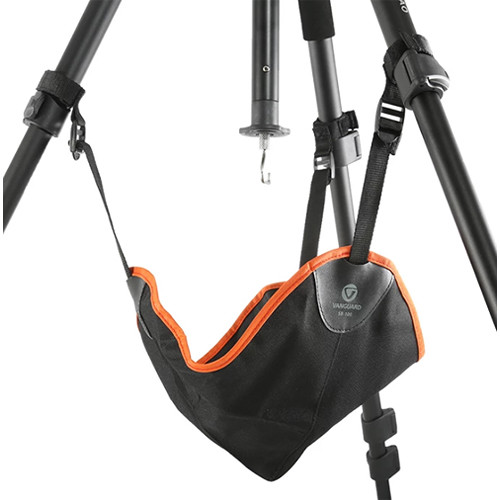
Tripod FAQs:
What’s the best tripod for wildlife photography?
The best tripod depends on your gear and environment, but a carbon fiber tripod with high load capacity and a gimbal or ball head is an excellent starting point for most wildlife photographers. Look for models that are durable, weather-resistant, and easy to set up in the field.
How much weight should a tripod support?
Your tripod should support at least 1.5 to 2 times the combined weight of your camera and heaviest lens. This ensures stability, especially in windy conditions or uneven terrain.
Are carbon fiber tripods worth the investment?
Yes – especially for wildlife photography. Carbon fiber is lightweight, strong, and vibration-dampening, making it ideal for long treks and steady shots.
What type of tripod head is best for wildlife?
A gimbal head is often preferred for large telephoto lenses, allowing smooth panning and tracking of moving animals. Ball heads are more compact and versatile but may not be as fluid for tracking fast subjects.
Twist locks vs. flip locks – what’s better?
On the one hand, twist locks are more streamlined and often better sealed against dirt and moisture. On the other hand, flip locks can be faster to use and easier with gloves. It comes down to personal preference and how you shoot.
How tall should my tripod be?
Ideally, your tripod should reach eye level without extending the center column. This gives you the best balance of comfort and stability, especially when shooting for long periods.
Conclusion: Your Three-Legged Trail Companion
In the wild, your tripod isn’t just gear – it’s your patient, unshakable sidekick. While you’re ducking under branches, whispering to yourself about lighting, or trying not to scare off that mountain lion in the distance (don’t worry, it probably saw you first), your tripod is there. Rock steady. Always ready.
Whether you’re trekking into high alpine meadows or crawling through the brush for that low-angle eye-lock shot, the right tripod gives you confidence, stability, and freedom to focus on the magic. Pick one that suits your style and doesn’t make you curse its weight halfway up a hill and it’ll be with you through every sunrise stakeout and golden hour rush.
Because out here, you don’t just need legs – you need great ones.




